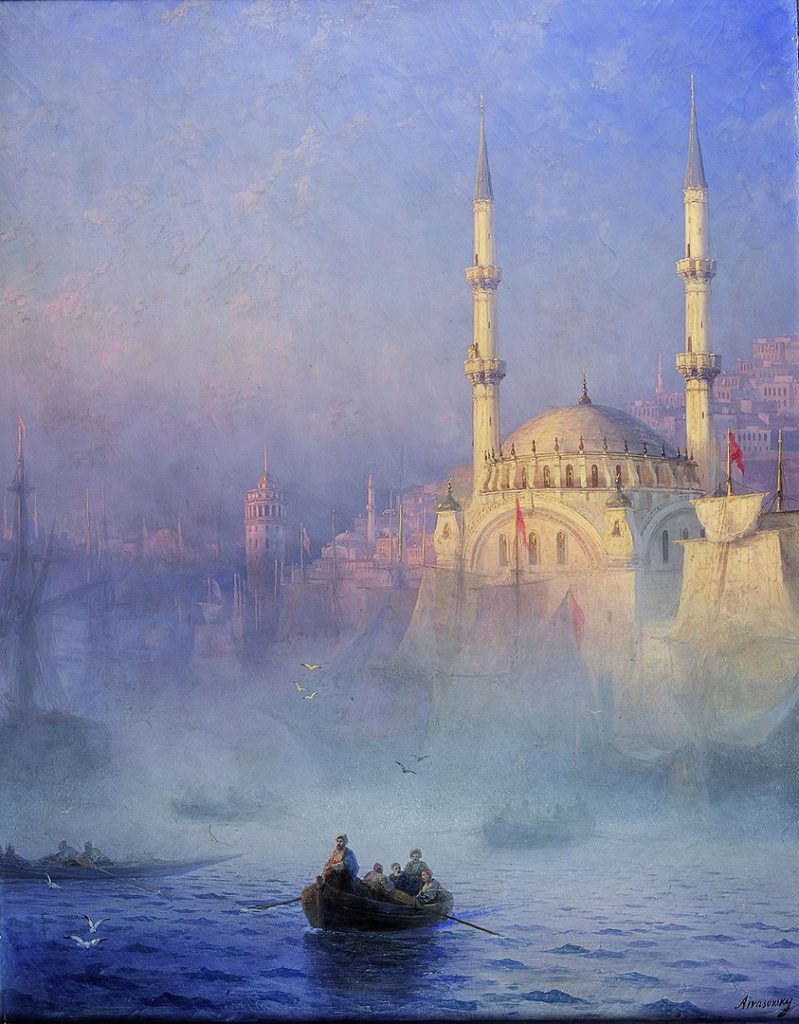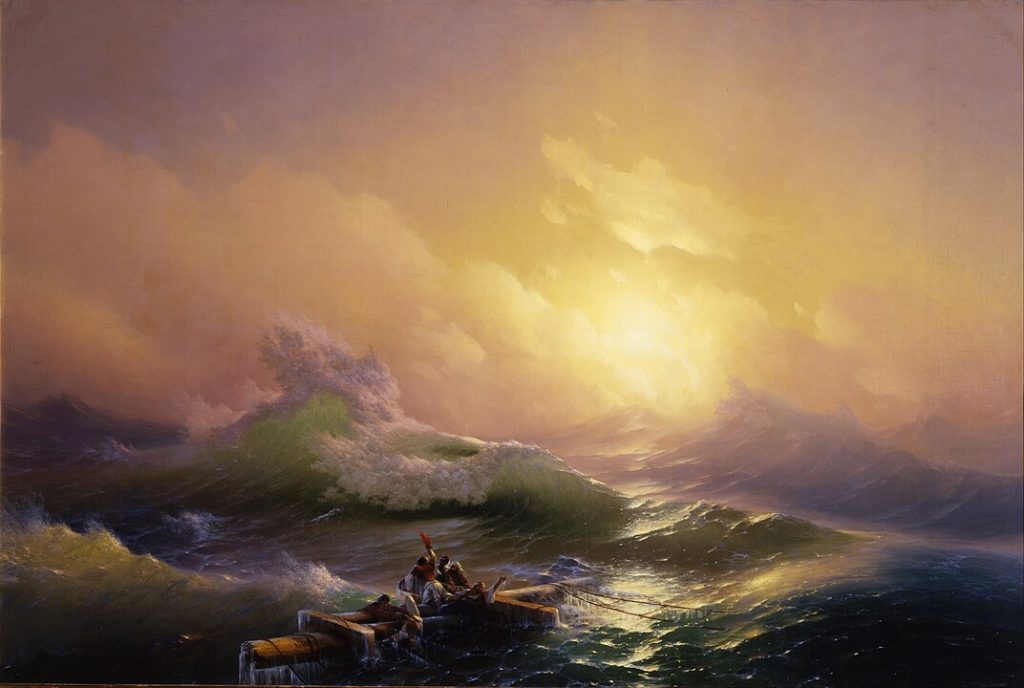
Ivan Konstantinovich Aivazovsky stands as one of the most celebrated marine painters in history, renowned for his breathtaking seascapes that capture the movement and majesty of the ocean. His ability to depict water with unmatched realism and luminosity set him apart from his contemporaries, earning him admiration from both Russian and European audiences. Aivazovsky’s paintings, often filled with stormy seas, golden sunsets, and naval battles, evoke deep emotions and tell powerful visual stories. His work remains influential, continuing to captivate art lovers and scholars worldwide.
Aivazovsky’s career spanned more than six decades, during which he produced over 6,000 paintings, an astounding number for any artist. His talent was recognized early, allowing him to study at the prestigious Imperial Academy of Arts before traveling through Europe to refine his craft. By the mid-nineteenth century, he was already regarded as a master of marine painting, earning commissions from Russian tsars and European nobility alike. His art was exhibited in major cities such as Paris, London, and Venice, solidifying his international reputation.
Beyond his artistic achievements, Aivazovsky led a fascinating life filled with patronage from royalty, personal relationships that shaped his work, and a deep commitment to his Armenian heritage. He was not only an artist but also a philanthropist, using his success to support the arts and charitable causes in his hometown of Feodosia. His legacy endures through his paintings, which remain prominently displayed in museums and private collections worldwide.
This article explores the life and work of Ivan Aivazovsky, from his early years in Crimea to his rise as Russia’s greatest maritime painter. It will examine his influences, major artistic achievements, and the personal aspects of his life that contributed to his extraordinary career. Through this exploration, readers will gain a deeper understanding of why Aivazovsky remains a towering figure in nineteenth-century art.
Early Life and Artistic Beginnings
Ivan Konstantinovich Aivazovsky was born on July 29, 1817, in the port city of Feodosia, Crimea, into an Armenian merchant family. His birth name was Hovhannes Aivazian, reflecting his Armenian heritage, though he would later adopt the more Russian-sounding version of his name. His father, Konstantin Aivazovsky, had once been a prosperous merchant but had suffered financial losses, leaving the family in a modest economic position. Despite their struggles, young Ivan displayed an early talent for drawing, sketching ships and the sea from a young age.
His artistic abilities caught the attention of local officials, particularly Governor Alexander Kaznacheyev, who recognized his potential and provided him with support. Through this encouragement, Aivazovsky was sent to the Simferopol Gymnasium, where he received his first formal education. His skill in painting and drawing quickly outpaced his peers, leading to a recommendation for further studies in St. Petersburg. In 1833, at just sixteen years old, he was accepted into the Imperial Academy of Arts, one of the most prestigious institutions in Russia.

At the academy, Aivazovsky studied under Maxim Vorobyov, a respected landscape painter known for his meticulous attention to nature’s details. He also learned from Alexei Venetsianov, who emphasized capturing everyday scenes with emotional depth. While other students struggled to master perspective and composition, Aivazovsky excelled, particularly in his ability to depict water and sky. His early works stood out for their dramatic lighting and movement, characteristics that would later define his mature style.
Despite financial hardships, Aivazovsky remained dedicated to his craft, constantly refining his technique. His talent did not go unnoticed, and he was soon winning academic competitions and receiving praise from instructors. His time at the academy laid the foundation for his future success, preparing him for a career that would eventually make him one of the most revered painters in Russian history.
Academic Training and Early Success
Aivazovsky’s years at the Imperial Academy of Arts were crucial in shaping his artistic identity. The rigorous training he received helped him develop technical precision, particularly in the depiction of landscapes and atmospheric effects. Under the guidance of his mentors, he learned the delicate interplay of light, water, and sky—elements that would become the hallmark of his work. His passion for marine painting grew stronger, setting him apart from his fellow students.
His breakthrough moment came in 1837 when he won a gold medal for one of his landscape paintings. This prestigious award granted him the opportunity to travel abroad, a rare privilege that allowed young artists to refine their craft in European art capitals. Before embarking on his journey, he was selected for a special residency in Crimea, where he painted seascapes that showcased his emerging style. His works from this period already displayed a mastery of movement and atmosphere, leading critics to compare him to European masters.

In 1840, Aivazovsky traveled to Italy, where he was exposed to the works of renowned painters such as J.M.W. Turner and Claude Lorrain. He was deeply influenced by the Italian tradition of landscape painting, particularly the use of warm, glowing light to enhance natural scenery. The artistic environment in Rome, Florence, and Venice further expanded his understanding of composition and color. During his time in Italy, he produced numerous paintings that would later define his early European reputation.
His work quickly gained recognition, and he exhibited his paintings in major European cities, where they were met with great acclaim. Critics praised his ability to convey the energy and vastness of the sea, a quality that set him apart from other landscape painters of his time. By the time he returned to Russia in 1844, he was already an internationally celebrated artist, with a reputation that would continue to grow in the years to come.
Establishing His Career and Royal Recognition
Upon his return to Russia, Aivazovsky was appointed the official artist of the Russian Navy, a prestigious position that allowed him to document naval history through his paintings. This role provided him with exclusive access to military engagements, ships, and seafarers, further deepening his understanding of maritime life. His ability to depict naval battles and stormy seas with both accuracy and drama made his work highly desirable among military officials and collectors alike.
One of his most important patrons was Tsar Nicholas I, who commissioned several paintings to commemorate Russian naval victories. Aivazovsky’s works from this period often depicted historical battles, including epic confrontations between Russian and Ottoman fleets. His ability to capture movement and emotion in his compositions made these paintings particularly compelling. One of his most celebrated works from this era, “Brig Mercury Defeating Two Turkish Ships” (1848), highlights the heroism and skill of Russian sailors.
As his fame spread, Aivazovsky’s work was exhibited across Europe, further establishing his status as a master of marine painting. He gained recognition not only in Russia but also in Paris, London, and Amsterdam, where his paintings were widely admired. His seascapes, which balanced realism with romanticism, resonated with audiences who were drawn to his dramatic yet poetic interpretation of the sea. Collectors and aristocrats eagerly sought his works, making him one of the most successful painters of his time.
Despite his growing international fame, Aivazovsky remained deeply connected to his homeland. He frequently traveled between St. Petersburg and Crimea, drawing inspiration from the landscapes and coastal scenes of the Black Sea. His dedication to capturing the beauty and power of the ocean never wavered, and his paintings continued to be in high demand. By the mid-nineteenth century, he had solidified his place as Russia’s greatest marine painter.
Signature Style and Notable Works
Aivazovsky’s artistic style was instantly recognizable and deeply evocative, defined by his ability to depict the motion of water, the interplay of light, and the sheer vastness of the sea. His mastery of maritime scenes set him apart from his contemporaries, as he was able to render the waves with astonishing realism and emotional depth. He often depicted the sea in various states, from tranquil sunlit waters to violent, stormy tempests, giving his paintings a dramatic and almost otherworldly quality. His use of color, particularly his luminous treatment of light reflecting off the ocean, became one of his most defining techniques.
One of his most famous paintings, “The Ninth Wave” (1850), is a powerful example of his ability to blend realism with romanticism. The painting depicts shipwreck survivors clinging to the remains of a mast while enormous waves crash around them, bathed in the warm glow of the morning sun. This work conveys both the terrifying power of the ocean and the resilience of the human spirit, making it one of his most beloved and studied pieces. Another significant work, “Brig Mercury Defeats Two Turkish Ships” (1848), showcases his talent for historical naval scenes, illustrating a moment of Russian naval triumph with meticulous detail.
Throughout his career, Aivazovsky continued to paint large-scale seascapes that captivated audiences with their intensity and grandeur. His painting “The Black Sea” (1881) presents the ocean as an almost living entity, with waves rolling endlessly toward the viewer, creating a sense of both beauty and menace. Another masterpiece, “Among the Waves” (1898), is often regarded as his finest work, featuring a stormy sea without any human presence—an unusual choice that highlights his deep appreciation for the sea as an independent force of nature. His ability to capture water’s fluidity and unpredictability set a new standard for maritime painting.
Aivazovsky’s works were not just appreciated in Russia but also across Europe, where he exhibited in major cities such as Paris, London, and Rome. His international reputation was solidified when he became an honorary member of the French Academy of Fine Arts. Collectors and art lovers sought out his paintings, and his name became synonymous with marine art. His ability to convey emotion through landscape painting, combined with his extraordinary technical skill, made him one of the most admired artists of his era.
Personal Life and Relationships
Despite his fame and artistic success, Aivazovsky’s personal life was filled with moments of both joy and difficulty. In 1848, he married Julia Graves, an English governess who had moved to Russia. Their marriage lasted for nearly three decades, but it eventually ended in divorce in 1877. The reasons for their separation remain largely private, though it is believed that their different cultural backgrounds and Aivazovsky’s dedication to his work may have played a role. The divorce was a difficult period for the artist, but he soon found love again.
In 1882, Aivazovsky married Anna Burnazian, a fellow Armenian who shared his deep cultural roots. Their marriage was much more harmonious, and she remained by his side until his death. His strong connection to his Armenian heritage was evident in his later years, as he frequently contributed to Armenian cultural and charitable causes. He even painted works that reflected his Armenian identity, including “The Expulsion of the Turks from Armenia” (1892), which expressed his patriotism and historical awareness.
Aivazovsky was also known for his generosity and hospitality, often opening his home in Feodosia to artists, writers, and intellectuals. His estate became a meeting place for some of the most prominent figures of the time, fostering discussions on art, literature, and philosophy. He supported young artists, helping them gain access to education and resources, much like the support he had received in his youth. His passion for mentoring and philanthropy further cemented his legacy beyond his paintings.
Although much of Aivazovsky’s life was dedicated to his art, he was also a devoted family man and a respected member of his community. His later years were filled with both artistic triumphs and personal contentment, as he enjoyed the recognition of his work while being surrounded by his loved ones. His ability to balance his artistic pursuits with his personal commitments reflected the depth of his character and the lasting impact he had on those around him.
Later Years and Enduring Legacy
In his later years, Aivazovsky remained as prolific as ever, producing some of his most accomplished and atmospheric works. Even in his seventies and eighties, he continued to paint with the same passion and energy that had defined his early career. He experimented with new compositions and lighting effects, always striving to capture the essence of the sea in new and dynamic ways. His commitment to his craft never wavered, and his reputation continued to grow.
He also dedicated much of his later life to philanthropy, particularly in Feodosia, where he founded an art school to train young painters. He donated many of his works to public institutions and played a key role in establishing the Feodosia Art Gallery, which became a cultural landmark in the region. His contributions to the city were widely recognized, and he was honored with numerous awards and accolades in his final years. His dedication to both his art and his community showcased the depth of his character.
On May 2, 1900, Aivazovsky passed away at the age of eighty-two, leaving behind an extraordinary artistic legacy. His death marked the end of an era in Russian art, but his influence did not fade. His works remained in high demand, and exhibitions of his paintings continued to attract large audiences. His ability to capture the ocean’s raw power and ethereal beauty ensured that his name would be remembered for generations to come.
Today, Aivazovsky’s paintings are housed in major museums such as the Hermitage Museum in St. Petersburg, the Tretyakov Gallery in Moscow, and various collections around the world. His influence extends beyond marine painting, inspiring countless artists who seek to capture nature’s grandeur. His work remains a testament to his unparalleled ability to bring the sea to life, securing his place as one of the greatest painters of the nineteenth century.
Aivazovsky’s Influence on Art and Culture
Aivazovsky’s impact on the world of art extends far beyond his own paintings. His ability to capture the sea’s movement and vastness set a new standard for marine painting, influencing both Russian and European artists. His work was admired by painters across genres, including romanticists, realists, and impressionists who sought to understand his approach to light and atmosphere. His legacy as a master of seascapes remains unchallenged.
His contributions to Armenian and Russian culture were also significant, as he was deeply involved in preserving and promoting the heritage of both nations. His support for Armenian causes made him a national figure among Armenians, and his efforts to elevate the artistic community in Russia cemented his importance in Russian cultural history. His paintings often reflected his deep love for his homeland, further endearing him to the people of both nations.
Modern exhibitions continue to celebrate Aivazovsky’s contributions, with major retrospective shows held in Russia, Europe, and the United States. Art historians continue to study his techniques, analyzing how he achieved such lifelike depictions of water and light. His ability to balance historical storytelling with artistic beauty ensures that his work remains relevant even in contemporary times.
His influence extends beyond visual arts, inspiring poets, writers, and musicians who seek to capture the same sense of vastness and emotion in their own works. His paintings have been referenced in literature and film, demonstrating the timeless nature of his artistic vision. Aivazovsky’s ability to bring the sea to life ensures that his legacy will endure for centuries.
Key Takeaways
- Ivan Aivazovsky was one of the most influential marine painters in history, known for his dramatic seascapes.
- His works combined realism and romanticism, creating emotionally powerful and visually stunning compositions.
- He gained international fame, with exhibitions in Paris, London, and Rome, and was honored by Russian royalty.
- Aivazovsky was deeply connected to his Armenian heritage and contributed to cultural and charitable causes.
- His paintings continue to inspire artists and remain highly valued in museums and collections worldwide.
FAQs
- What was Ivan Aivazovsky best known for?
He was best known for his seascapes, which captured the movement, light, and atmosphere of the ocean with remarkable realism. - How many paintings did Aivazovsky create?
He painted over 6,000 works, making him one of the most prolific artists of the nineteenth century. - What is Aivazovsky’s most famous painting?
“The Ninth Wave” (1850) is his most renowned painting, depicting shipwreck survivors battling enormous waves. - Did Aivazovsky have royal patrons?
Yes, Tsar Nicholas I and other members of Russian nobility commissioned many of his works. - Where can Aivazovsky’s paintings be seen today?
His works are displayed in major museums, including the Hermitage Museum and the Tretyakov Gallery.




